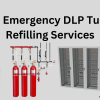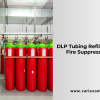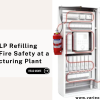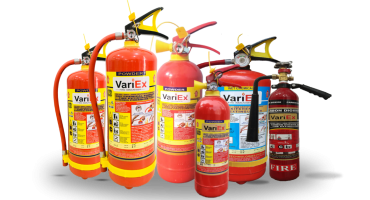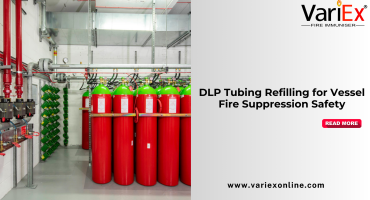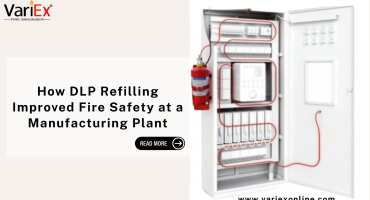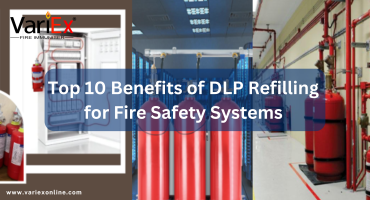![]()
Fire Immuniser
+91-7829629111
Email: info@variex.in
Varistor Technologies Pvt. Ltd.
Block-1, First Floor, Ardente Office One, Hoodi Circle, ITPL Main Road, Bengaluru, Karnataka 560048, IN
Preventive Maintenance Checklist After DLP Fire Tubing Refilling
Preventive Maintenance Checklist After DLP Fire Tubing Refilling
DLP (Direct Low Pressure) fire suppression systems are essential for protecting sensitive environments like manufacturing units, data centers, marine vessels, and commercial spaces. After refilling the DLP tubing, preventive maintenance is critical to ensure the system functions optimally during a fire emergency. Ignoring post-refill maintenance can lead to system failures, compliance violations, and increased fire risks.
In this blog, we’ll cover a comprehensive preventive maintenance checklist, best practices, and expert tips to help you maintain your DLP fire tubing system in peak working condition after every refill.
Why Preventive Maintenance Matters After DLP Tubing Refilling
Preventive maintenance is the first line of defense against unexpected equipment failures. Here's why it is crucial after refilling:
-
✅ Detects leaks or pressure loss early.
-
✅ Extends the lifespan of tubing and suppression agents.
-
✅ Ensures fire protection compliance with standards like NFPA, IS, and UL.
-
✅ Minimizes downtime of critical equipment.
-
✅ Safeguards people, property, and operations.
Without proper maintenance, a freshly refilled system could develop undetected faults, rendering the entire fire suppression system ineffective.
Key Preventive Maintenance Activities Post DLP Tubing Refill
After a DLP tubing refill, fire safety teams should follow a structured preventive maintenance program. Here’s a comprehensive checklist categorized by task types:
✅ Visual Inspections
-
Inspect the DLP tubing for any physical damage, cracks, or discoloration.
-
Check for loose or improperly secured tubing connections.
-
Verify that the tubing path is clear of obstructions like dust or debris.
-
Look for signs of rodent damage or corrosion on the tubing.
✅ Pressure & Leak Testing
-
Test the system’s pressure levels to ensure they are within manufacturer-recommended ranges.
-
Perform leak detection tests using approved soap solutions or electronic sniffers.
-
Confirm that all joints and connectors are leak-free post-refilling.
✅ Functional System Tests
-
Conduct discharge simulation tests without releasing the actual agent.
-
Verify the functionality of fire alarm integrations.
-
Test the manual and automatic activation mechanisms of the system.
✅ Documentation and Compliance
-
Update refill and maintenance logs as per local fire safety regulations.
-
Record inspection findings and corrective actions taken.
-
Ensure compliance with NFPA 2001, IS 15325, or equivalent fire safety standards.
✅ Technician Training & Awareness
-
Train your maintenance team to identify early warning signs.
-
Schedule regular refresher training on DLP system operations.
Preventive Maintenance Checklist Table
| Maintenance Task | Frequency | Who Performs | Tools Required | Remarks |
|---|---|---|---|---|
| Visual inspection of tubing & fittings | Monthly | In-house team | Flashlight, inspection mirror | Look for damage or obstructions |
| Pressure verification | Quarterly | Certified technician | Pressure gauge | Ensure optimal operating pressure |
| Leak detection testing | Quarterly | Certified technician | Leak detector, soap solution | Check all joints and connectors |
| Discharge simulation test | Bi-annually | Fire safety contractor | Test panels | Simulate fire scenario |
| Tubing route clearance check | Monthly | In-house team | Visual inspection | Remove dust, debris, or barriers |
| Electrical system check (alarms, detectors) | Quarterly | Electrician/Technician | Multimeter | Ensure reliable fire alerts |
| Fire safety documentation update | After every activity | Fire Safety Manager | Maintenance logbook | For compliance audits |
| Staff training on emergency procedures | Annually | Safety Officer | Training manuals | Improve emergency response readiness |
| Review of compliance with fire safety standards | Annually | Safety Consultant | Standard checklists | Align with NFPA, IS codes |
Signs of Potential Post-Refill Issues to Watch Out For
After the refill and maintenance process, keep an eye on these early warning signs that may require immediate intervention:
-
⚠️ Sudden pressure drops on monitoring gauges.
-
⚠️ Audible hissing or air leakage from tubing joints.
-
⚠️ Fire panel faults or false alarms.
-
⚠️ Visible cracks or wear in tubing over time.
-
⚠️ Difficulty in system activation during testing.
Proactive responses to these issues can prevent emergency failures.
Best Practices for Long-Term DLP Tubing System Maintenance
To get the most out of your fire suppression system, implement these best practices:
-
✔️ Always use certified refill agents and OEM-approved parts.
-
✔️ Schedule quarterly inspections rather than waiting for annual checks.
-
✔️ Establish an SLA with a trusted fire safety service provider.
-
✔️ Document every refill, inspection, and corrective action for compliance.
-
✔️ Train all staff working near DLP tubing on basic fire safety protocols.
How Often Should DLP Tubing Be Refilled?
While the refill frequency depends on the size of the system and the environment, most DLP systems are refilled every 1 to 3 years or immediately after a discharge. Preventive maintenance ensures that no leakage or pressure loss occurs in the interim.
Industry Applications That Rely on Preventive Maintenance
DLP fire tubing systems are used across industries such as:
-
📦 Warehousing & Logistics
-
⚙️ Manufacturing & Assembly Lines
-
🔌 Electrical Panels & Switchgear
-
🚢 Marine Vessels
-
🖥️ Data Centers & Server Rooms
-
🚗 Automotive Paint Booths
In these environments, downtime caused by fire risks can be costly, making preventive maintenance critical.
Conclusion
DLP tubing refilling is not a one-time task; it’s part of a broader fire safety lifecycle. A structured preventive maintenance checklist post-refill can help minimize system failures, ensure compliance, and protect lives and property.
Partner with a certified fire suppression service provider to conduct timely refills and preventive maintenance checks. Regular inspection, testing, and documentation are the cornerstones of a safe and compliant workplace.
Frequently Asked Questions
Preventive maintenance should be done monthly for inspections and quarterly for pressure and leak tests.
Certified fire safety technicians and trained in-house maintenance teams.
The system should be depressurized, the faulty part replaced, and pressure retested before resuming operations.
Yes, they are required by fire safety standards like NFPA 2001, IS 15325, and local fire codes.
Yes, most visual inspections and pressure tests can be done without disrupting business operations.
Final Say
At VariEx.in and VariexOnline.com, we specialize in supplying and installing top-quality fire fighting systems and equipment. From fire extinguishers to advanced suppression systems, we offer comprehensive solutions tailored to your needs. Our experienced team ensures precise installation and maintenance for optimal safety.
Trust VariEx for reliable fire protection. Contact us online or call 7829629111 to learn more.
We specialize in manufacturing, supplying, and distributing a comprehensive range of fire fighting equipment, including state-of-the-art fire extinguishers. Read our most searched blogs and find interesting information on topics such as how to use a fire extinguisher, how to calculate fire fighting water tank capacity, fire extinguisher refilling, obtaining a Fire NOC, understanding fire fighting systems, types of fire protection systems, the fire hydrant system, and the fire sprinkler system. These resources provide essential knowledge for ensuring safety and compliance with fire safety regulations. Additionally, you can explore guides on the maintenance of fire protection equipment, the latest advancements in fire safety technology, and best practices for fire risk assessment and management.
Our expertise extends to fire alarm systems, fire hydrant systems, and fire suppression systems, including fire sprinklers. Each product meets rigorous international standards for reliability and performance, ensuring effective fire safety products tailored to diverse applications and industries. Additionally, we are providing Fire Extinguisher Refilling and AMC services to ensure ongoing maintenance and operational readiness of fire safety equipment.



